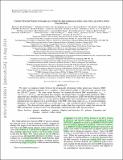Connection between dynamically derived initial mass function normalisation and stellar population parameters
Abstract
We report on empirical trends between the dynamically determined stellar initial mass function (IMF) and stellar population properties for a complete, volume-limited sample of 260 early-type galaxies from the Atlas3D project. We study trends between our dynamically-derived IMF normalisation and absorption line strengths, and interpret these via single stellar population- (SSP-) equivalent ages, abundance ratios(measured as [alpha/Fe]), and total metallicity, [Z/H]. We find that old and alpha-enhanced galaxies tend to have on average heavier (Salpeter-like) mass normalisation of the IMF, but stellar population does not appear to be a good predictor of the IMF, with a large range of normalisation at a given population parameter. As a result, we find weak IMF-[alpha/Fe] and IMF-age correlations, and no significant IMF-[Z/H]correlation. The observed trends appear significantly weaker than those reported in studies that measure the IMF normalisation via low-mass star demographics inferred through stellar spectral analysis.
Citation
McDermid , R M , Cappellari , M , Alatalo , K , Bayet , E , Blitz , L , Bois , M , Bournaud , F , Bureau , M , Crocker , A F , Davies , R L , Davis , T A , de Zeeuw , P T , Duc , P-A , Emsellem , E , Khochfar , S , Krajnovic , D , Kuntschner , H , Morganti , R , Naab , T , Oosterloo , T , Sarzi , M , Scott , N , Serra , P , Weijmans , A-M & Young , L M 2014 , ' Connection between dynamically derived initial mass function normalisation and stellar population parameters ' , Astrophysical Journal Letters , vol. 792 , no. 2 , L37 . https://doi.org/10.1088/2041-8205/792/2/L37
Publication
Astrophysical Journal Letters
Status
Peer reviewed
ISSN
2041-8205Type
Journal article
Description
The authors thank the referee for helping to improve this article. The research leading to these results has received funding from the European Community’s Seventh Framework Programme (/FP7/2007-2013/) under grant agreement No 229517. MC acknowledges support from a Royal Society University Research Fellowship. This work was supported by the rolling grants PP/E001114/1 and ST/H002456/1 and visitors grants PPA/V/S/2002/00553, PP/E001564/1 and ST/H504862/1 from the UK Research Councils. RLD acknowledges grants from Christ Church, Oxford and support from the Royal Society Wolfson Merit Award 502011.K502/jd. SK acknowledges support from the Royal Society Joint Projects Grant JP0869822. TN and MBois acknowledge support from the DFG Cluster of Excellence ‘Origin and Structure of the Universe’. MS acknowledges support from a STFC Advanced Fellowship ST/F009186/1. LY acknowledges support from NSF grant AST-1109803. The authors acknowledge financial support from ESO.Collections
Items in the St Andrews Research Repository are protected by copyright, with all rights reserved, unless otherwise indicated.

